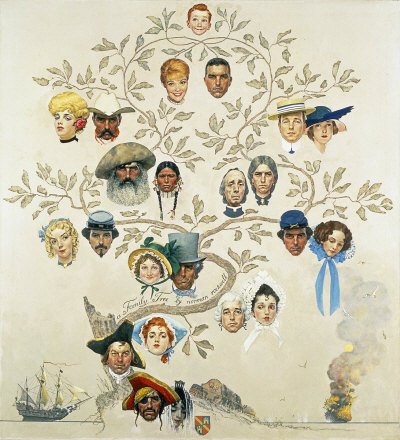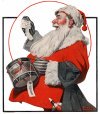 |
||||||||||||||
Family Tree by Norman Rockwell
October 24, 1959 Issue of The Saturday Evening PostFamily Tree, a Norman Rockwell painting , appeared on the cover of The Saturday Evening Post published October 24, 1959. This is another timeless favorite of Rockwell collectors, a classic for all the ages. This painting was Rockwell's 307th overall out of 322 total paintings that were published on the cover of the Saturday Evening Post. Rockwell's career with the Post spanned 47 years, from his first cover illustration, Boy With Baby Carriage in 1916 to his last, Portrait of John F. Kennedy, in 1963. This was also the fourth cover for The Post in 1959. In 1959, there were four Norman Rockwell Saturday Evening Post covers published. The original oil on canvas painting, 46 x 42 inches or 117 x 106.5 cm, is part of the collection of the Norman Rockwell Museum of Stockbridge, MA. This painting also appears in five Rockwell commentary books. It appears:
Two studies also appear in the Norman Rockwell Catalogue on pages 224 and 225. Rockwell recounts his creative trials and tribulations in creating this painting in his autobiography, My Adventures as an Illustrator. Pristine original copies of this magazine cover sell for big bucks on eBay, when it is offered. And to think it only cost fifteen cents originally! And it was mint condition then, too. Family TreeGiclee Prints on Archival Paper: Norman Rockwell goes over how he almost agonized over the details of this painting in Norman Rockwell's autobiography, My Adventures as an Illustrator, so I would recommend that you read that book if you are a serious fan of his works. Suffice it to say, he did many revisions of most of the characters in the painting before he arrived at the published image. In this painting, Rockwell paints a fictional family tree for a fictional boy, seen at the topmost part of the painting. Of course, not every ancestor of the boy is represented. Rockwell starts his narrative painting with an unlikely ancestor, washed ashore in the new world. That ancestor would be the the pirate seen at the very bottom. He is wedded to a beautiful lady of the same time period. Rockwell was concerned that the audience would not recognise the swarthy fellow as a pirate. To ensure that the readers would recognise the character as a swashbuckler, Rockwell added the treasure chest at the foot of the tree, as well as the pirate ship on the right, engulfed in flames on its way to Davy Jones locker. The pirate ship had lost its battle with the Navy frigate shown on the left side of the painting. Several more generations are presented in the picture. The boy has ancestors in his family tree who fought on both sides during the civil war. Just above the Union soldier, we can see Rockwell himself portraying a preacher. Right beside the preacher and his wife, we can see the frontiersman fur trapper and his Native American wife. The next row up shows us a cowboy, maybe a Rough Rider, and his wife, the saloon girl. Contrasting with the cowboy and the saloon girl, over on the right hand side, Rockwell shows us a city couple. The next row up shows the little boy's parents, who look really plain and normal, given all the diversity presented in the lower, olders branches of the family tree. Looking more closely, we can see that the same face model for the boys father was also the same model for several of the other characters, including the pirate, the cowboy, the city slicker, the Union soldier, the Confederate soldier and the colonial man wearing the white wig. Even the parson's wife is modeled by the same man as the boy's father. Look closely. In fact, all the male models except Rockwell himself and the little boy seem to have the same person portraying them. Family Tree was only one of 322 Norman Rockwell Saturday Evening Post covers; Here is the list of Norman Rockwell Saturday Evening Post cover illustrations.
Here is the complete list of all Norman Rockwell magazine covers. The women in the painting, except for the preacher's wife, appear to all have been different models. It is also interesting to look at the studies presented in Norman Rockwell Catalogue and see the different stages in the completion of this storytelling masterpiece by Norman Rockwell, Family Tree.
Norman Rockwell's Family Tree (1959)
Remember to check back often.
|
Norman Rockwell Quotes:I'll never have enough time to paint all the pictures I'd like to. No man with a conscience can just bat out illustrations. He's got to put all his talent and feeling into them! Some people have been kind enough to call me a fine artist. I've always called myself an illustrator. I'm not sure what the difference is. All I know is that whatever type of work I do, I try to give it my very best. Art has been my life. Right from the beginning, I always strived to capture everything I saw as completely as possible. The secret to so many artists living so long is that every painting is a new adventure. So, you see, they're always looking ahead to something new and exciting. The secret is not to look back. I can take a lot of pats on the back. I love it when I get admiring letters from people. And, of course, I'd love it if the critics would notice me, too. You must first spend some time getting your model to relax. Then you'll get a natural expression. More at BrainyQuote. Rockwell Favorites
|
|||||||||||||
|
|
||||||||||||||
|
Images are copyrighted by their respective copyright holders. Graphic Files Protected by Digimarc. Contact us for details about using our articles on your website. The only requirements are an acknowledgement and a link.
|
||||||||||||||
















